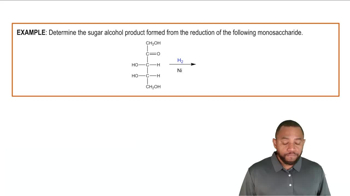How are the following pairs of carbohydrates, shown in a Fischer projection, related to each other? Are they structural isomers, enantiomers, diastereomers, or epimers?
(a)
 Verified step by step guidance
Verified step by step guidance Verified video answer for a similar problem:
Verified video answer for a similar problem:



 2:37m
2:37mMaster Classification of Carbohydrates Concept 1 with a bite sized video explanation from Jules
Start learning